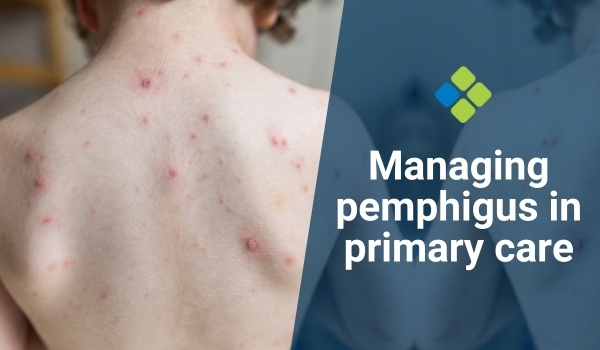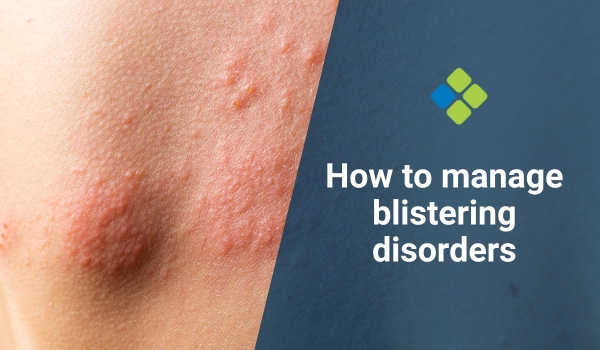Managing pemphigus in primary care
Read more about how to manage pemphigus in a primary care setting, including the vital role of the GP in its early recognition, diagnosis, and treatment.

HealthCert Education
Pemphigus is a complex condition that requires careful management. Primary care doctors, with adequate training in general dermatology, can play a vital role in early recognition, diagnosis, and prompt treatment of pemphigus, thereby improving the quality of life of their patients.
This article outlines the key components of managing pemphigus in a primary care setting.
What is pemphigus?
Pemphigus is not a single disease but a group of rare, autoimmune blistering disorders that primarily affect the skin and mucous membranes. The condition occurs when the body’s immune system mistakenly targets proteins in the skin. This causes the formation of blisters and erosions. The two most common types are:
- Pemphigus vulgaris (PV)
- Pemphigus foliaceus (PF)
Pemphigus vulgaris is a more severe form. The condition can lead to significant morbidity, so effective management is vital.
Diagnosing pemphigus
The correct diagnosis is the first step in managing pemphigus. The presence of painful, flaccid blisters, erosions, or ulcers on the skin and/or mucosal surfaces (oral cavity, genitals) is the first obvious sign. However, confirmation typically requires laboratory testing.
A skin biopsy of the edge of a blister can reveal intraepidermal cleavage and the presence of acantholytic cells.
Direct immunofluorescence is another test that detects the deposition of immunoglobulins (IgG) and complement along the epidermal cell surface, which is diagnostic of pemphigus.
A serologic test that shows elevated levels of anti-desmoglein (Dsg) antibodies, particularly anti-Dsg1 and anti-Dsg3, can help confirm the diagnosis.
Treating pemphigus in a primary care setting
Rapid initiation of treatment is essential to control the disease and prevent complications, such as secondary infections or fluid loss. The primary goals are to:
- Control blister formation,
- Reduce inflammation, and
- Minimize the need for long-term immunosuppression
High-dose systemic corticosteroids (prednisone) are the first-line treatment for pemphigus. Dosing typically starts at 1-2 mg/kg/day, adjusted based on the patient’s response and side effects.
Where there is a need to reduce the need for long-term corticosteroid application, steroid-sparing agents such as azathioprine, mycophenolate mofetil, or methotrexate are commonly used.
Management of mucosal involvement
Pemphigus commonly affects the mucous membranes, particularly the oral cavity. These lesions can cause significant pain and difficulty eating and drinking, leading to weight loss and dehydration.
Topical corticosteroids and immunosuppressive medications can be effective for managing mild oral lesions. Oral lesions are painful, so appropriate pain control with oral corticosteroids or topical anesthetics (lidocaine) is necessary. Maintaining good oral hygiene and avoiding irritants (spicy, acidic foods) helps to manage the symptoms.
Monitoring and adjustments
Continuous monitoring of disease activity and treatment side effects is critical in pemphigus management. Regular follow-up visits are necessary to adjust medication dosages and ensure optimal care. Regular clinical assessment of skin and mucosal lesions is necessary. Blood tests for anti-Dsg antibodies can also help monitor disease activity and treatment response.
Long-term steroid use can lead to complications such as osteoporosis, hypertension, and diabetes. Regular monitoring of bone density, blood pressure, and blood sugar levels is essential.
Immunosuppressive therapy increases the risk of infections, particularly opportunistic infections. Patients should be monitored for signs of infection, and vaccination against pneumococcus, influenza, and varicella should be considered.
Long-term management of pemphigus
Long-term management focuses on maintaining remission. Once the disease is under control, a gradual tapering of corticosteroids and immunosuppressive therapy is advised. Regular follow-up is necessary to detect early signs of relapse. If relapse occurs, treatment should be escalated to regain control of the disease.
– Dr Rosmy De Barros
For further information on this topic, you may be interested to learn more about the HealthCert online Professional Diploma program in General Dermatology.
Engaging with this blog can help meet your annual
|

How to claim your CPD hoursIf you consume educational webinars, podcasts, articles, or research on this blog, you can Quick Log CPD hours with the RACGP via the usual self-submission process. You will be asked to reflect on what you have learned, and you will require supporting evidence such as a screenshot.Download the RACGP’s guide to self-recording your CPD here. |
References
- Pollmann, R., Schmidt, T., Eming, R., & Hertl, M. (2018). Pemphigus: a comprehensive review on pathogenesis, clinical presentation and novel therapeutic approaches. Clinical reviews in allergy & immunology, 54, 1-25.
- Murrell, D. F., Peña, S., Joly, P., Marinovic, B., Hashimoto, T., Diaz, L. A., ... & Werth, V. P. (2020). Diagnosis and management of pemphigus: Recommendations of an international panel of experts. Journal of the American Academy of Dermatology, 82(3), 575-585.
- Mimouni, D., Nousari, C. H., Cummins, D. L., Kouba, D. J., David, M., & Anhalt, G. J. (2003). Differences and similarities among expert opinions on the diagnosis and treatment of pemphigus vulgaris. Journal of the American Academy of Dermatology, 49(6), 1059-1062.
- Ingen-Housz-Oro, S., Valeyrie-Allanore, L., Cosnes, A., Ortonne, N., Hüe, S., Paul, M., ... & Chosidow, O. (2015). First-line treatment of pemphigus vulgaris with a combination of rituximab and high-potency topical corticosteroids. JAMA dermatology, 151(2), 200-203.
- de Farias Morais, H. G., de Oliveira Costa, C. S., de Souto Medeiros, M. R., Carlan, L. M., Gonzaga, A. K. G., de Almeida Freitas, R., ... & de Oliveira, P. T. (2024). Pemphigus vulgaris and mucous membrane pemphigoid: A systematic review of clinical manifestations, diagnosis, and treatment. Journal of Stomatology, Oral and Maxillofacial Surgery, 101960.
- DE BACQUER, D., & LAMBERT, J. (2013). Evaluation of commercially available ELISA assays as a tool for monitoring and managing pemphigus patients: a prospective study. European Journal of Dermatology, 23(1), 33-9.
- Gregoriou, S., Efthymiou, O., Stefanaki, C., & Rigopoulos, D. (2015). Management of pemphigus vulgaris: challenges and solutions. Clinical, cosmetic and investigational dermatology, 521-527.

 1800 867 1390
1800 867 1390






